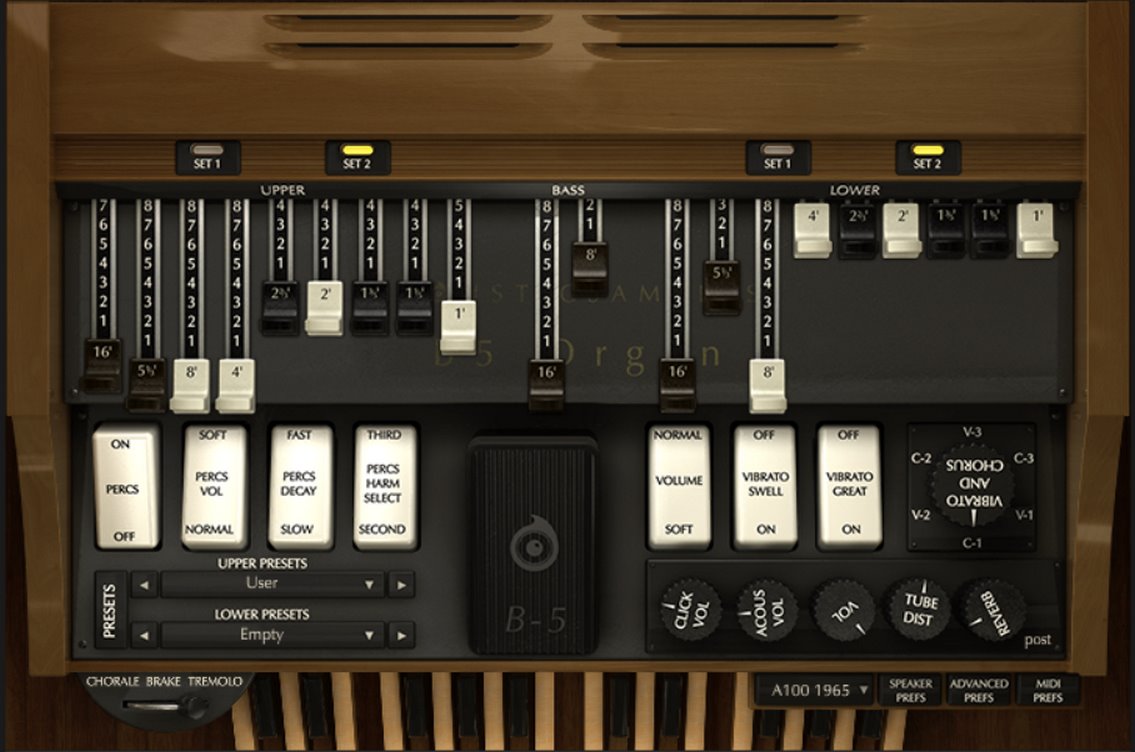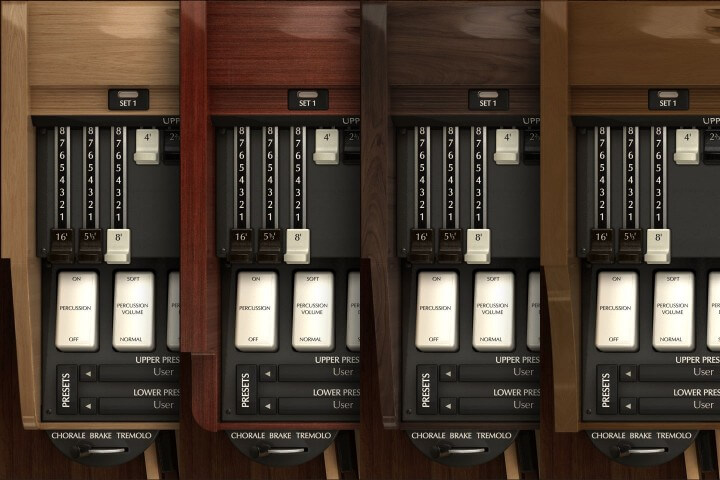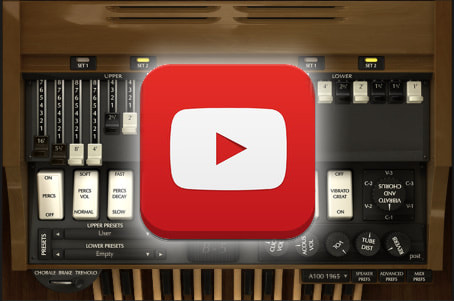AcousticSampleS B-5 V2 (Powerful) Review
I’m more than a little excited to announce that these failings are nowhere to be heard or seen in version 2. This redux sounds, plays, and operates extremely well (dare I say near perfectly?). The Leslie (rotating) cabinet emulation is very impressive. Microphone positioning and room size virtualization are superb here. Tonal balance and faithful, authentic-sounding tonewheel character are exploited to the fullest.
B-5 V2 normally lists for €99, but AcousticSampleS generously provide it au gratis as a FREE upgrade for those whom had already purchased the original version. * At the time of this publication, B-5 V2 is available for a short time at only €69!
Below, you’ll see a link to my prepared video presentation wherein I thoroughly explain the features and operation of B-5 V2 – there are also audio samples towards the end of the video. *Smile.
Here are a few things I’d like to bring to your attention first: Resource Demands: The bad news first. Due to the meticulous modeling technology that’s been implemented for both the instrument itself, and its stellar Leslie emulation, a moderately powered system is recommended in order to experience the wealth of Hammond goodness contained within B-5’s UVI format. The good news: AcousticSampleS Founder and lead developer, Arnaud Sicard, has been striving diligently to lower resources demand while retaining superior sound and performance quality. We’ve remained in contact throughout my bench-test/review of this fan-tab-u-lous virtual instrument. Thus, he’s kindly provided me with progressive, unpublished betas. I can assure you that previously experienced (heavy) resource demands have been lessened by a substantial degree – perhaps as much as 35 - 40 percent! Where Once There was One, There Now Are Four:
The original iteration of B-5 contained a single organ model and a basic Leslie emulation. With version 2, AcousticSampleS have raised the drawbar to spectacular proportions! Now we have not only the original B-5 organ still at hand – presumably for backwards compatibility – but there are four distinct tonewheel powerhouses on tap. These being: a 1968 B3, a ’69 C3, a ’65 A-100, and a 1960 C3. Not content to rest on blasé street, AcousticSampleS has gone the extra mile by skinning each model individually with lovely, photo-realistic interfaces.
The varying organ models faithfully reproduce the tones of their hardware fellows, and to the discriminating Hammond aficionado’s ears, sound very distinct from one another. Phase Aligned Samples and Hybrid Modeling: For the better part of 10 years, it's been generally agreed that GSI’s VB3 wore the tonewheel emulation crown as a synthesized, modeled, virtual Hammond organ. For good reason; it was (and remains) an exceptional tome of programming code. VB3 was far ahead of its digital peers in terms of authenticity, Leslie emulation, and functionality. Native Instruments “B4 II” also held a significant market share, but was superseded by NI’s “Vintage Organs” - a suite of sampled organs that included transistor compacts as well as tonewheels. I’ve always liked “Vintage Organs”, but there were a few niggles about it, such as minor tuning issues, phase misalignment on some notes, and its lackluster, passable rotary speaker emulation, that prevented it from becoming a top-tier choice. For those enlisting the affability of Logic Pro X on MAC systems, there is a very respectable virtual Hammond at their avail. AIR’s “DB-33” was released from Pro Tools confinement in 2014/15, but it’s rather on the ‘meh’ side of things and really not great as a standalone solution. It fares better when combined with a 3rd party rotary cabinet plug-in such as Melda’s “mVintageRotary” or PSP’s “L’otary 2”. DB-33 is probably ok for more heavily distorted Hammond-ish sounds. Of course, all aforementioned assessments are only the meanderings of this reviewer, but I suspect that most Hammond players, looking for a convincing alternative in-the-box, would agree with my findings. And now we come to it – how does AcousticSampleS’ B-5 V2 bear up under such scrutiny? Personally, I think it is well deserving of being coronated with the virtual Hammond crown. AcousticSampleS were definitely on the right track with their original release of B-5, but as mentioned earlier, there were a few disappointing characteristics about it. Those few quirks have been completely abated, and instead, we now have a princely capitulation of virtual tonewheel majesty. Of particular interest, is the fact that exceptional scripting is actualized in "B-5 V2", eliminating phase alignment issues -- causing it to pull well ahead of other contenders running in the sample-based pack. Thanks to AcousticSampleS’ hybrid modeling technology, over-the-top sonic realism and hands on performance credibility are here in spades! Get this – you can even adjust drawbars in *real-time free of glitches, pauses or interruptions. Unlike Kontakt-driven designs, this is a major step towards operational verity. All switches, knobs, drawbars and buttons devotedly mimic the original hardware.
Albeit, I prefer to use an iLok dongle since hard drives do sometimes crash and need replacing. If your machine goes ‘kapoots’ before you have an opportunity to return an activation to the Pace/iLok cloud, you’re out one of three possible activations. Machine-based activation is a bit of a gamble, but nevertheless, tends to be the preferred method of activation for those with an aversion to iLok dongles.
Installation:
This one’s about as easy as it gets. Create an account on the AcousticSampleS web site. *Don’t worry, it’s a basic setup that doesn’t require the whereabouts of your firstborn and your Social Insurance Number. *Grin. Upon successful (online) payment, your user account will then list your purchased product(s) with coordinating download links. Whenever newer product revisions are available, the download links are automatically updated. You download and install UVI’s free “Workstation” sample player from UVI.net or from the AcousticSampleS web site. Once installed, you simply extract the ufs file contained in the zip file(s) you’ve downloaded from AcousticSampleS, into the appropriate ** location on your system. ** There are configuration options within UVI Workstation for setting up library locations and etcetera.
Quick Overview of Additional Features:
All pertinent and expected Hammond appointments are well represented so we’ll not discuss those. Notwithstanding, here are some nifty additional features that I’d like to briefly highlight for you.
Stay in the Loop - Subscribe Today!
Brother Charles is a freelance writer, Gospel music artist and minister. Charles had been a professional touring musician during the nineties; working primarily as a lead guitarist in the Canadian country music industry. Brother Charles is also involved with music production and quality home recording.
2 Comments
10/31/2017 02:51:25 am
Excellent overview, I might even say "Fan-tab-u-lous."
Reply
Brother Charles
10/31/2017 06:36:44 pm
Hey RJ,
Reply
Your comment will be posted after it is approved.
Leave a Reply. |
NO SPAM! IK Multimedia Group Buy
FX Pick & Mix Group Buy - up to 16 for the price of 1
Will You Help?Web hosting is getting more and more expensive all the time, and Reviewer's Revival is NOT funded nor supported by any commercial enterprise or business. A donation of any amount is greatly appreciated. Even $2 or $3 for a coffee - every little bit helps. Thanks very much.
Legal BlurbAll of the articles published on Reviewer's Revival are undertaken to be purely objective, impartial reviews. Reviewer's Revival is not owned, funded-by, nor hired by any company or individual. Reviewer's Revival is the sole property of, and solely under the discretion and direction of Brother Charles. |










 15% OFF Summer Sale!
15% OFF Summer Sale!
 RSS Feed
RSS Feed

